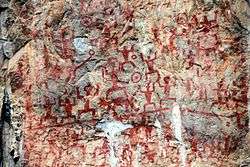Lạc Việt
The Lạc Việt or Luoyue (駱越 ~ 雒越; pinyin: Luòyuè ← Middle Chinese: *lɑk̚-ɦʉɐt̚ ← Old Chinese *râk-wat[1]) were an ancient conglomeration of Yue tribes (non-Han Chinese people) that inhabited what is today Guangxi in Southern China and the lowland plains of Northern Vietnam, particularly the marshy, agriculturally rich areas of the Red River Delta.[2] They are the owners of Bronze Age Đông Sơn culture in mainland Southeast Asia[3] and direct ancestors of Vietnamese people.[4]

Part of a series on the |
||||||||||||||||||||||||
|---|---|---|---|---|---|---|---|---|---|---|---|---|---|---|---|---|---|---|---|---|---|---|---|---|
| History of Vietnam | ||||||||||||||||||||||||
 | ||||||||||||||||||||||||
|
||||||||||||||||||||||||
|
Dominated
|
||||||||||||||||||||||||
|
||||||||||||||||||||||||
|
||||||||||||||||||||||||
|
||||||||||||||||||||||||
| Timeline | ||||||||||||||||||||||||
|
| ||||||||||||||||||||||||
In Vietnamese mythology, the Lạc, a giant, crane-like bird appeared to the ancient tribes in southern China and guided them through a difficult journey to northern Vietnam. This mysterious bird was later depicted on the elaborate bronze drums from the northern Vietnamese Đông Sơn culture that flourished during the Bronze Age. The Lạc people's ancestors called themselves the Lạc Việt after the bird in its honor.[5]
The ethnonym Lạc's etymology is uncertain. Based on Chinese observers' remarks that the Lạc people's paddies depended on water-control systems like tidal-irrigation & draining, so that the floody, swampy Red River delta might be suitable for agriculture, many scholars opted to find its etymology in the semantic field "water". Japanese scholar Gotō Kimpei links Lạc to Vietnamese noun(s) lạch ~ rạch "ditch, canal, waterway"[6]. Vietnamese scholar Vũ Thế Ngọc cites Nguyễn Kim Thản's opinion that Lạc simply means "water" and is comparable to phonetically similar elements in two compounds nước rạc (lit. "ebbing (tidal) water") & cạn rặc (lit. "utterly dried up [of water]"); indeed, Hồ Ngọc Đức's Free Vietnamese Dictionary Project glosses rặc as "means tidal water when falling"[7]. Meanwhile, Vũ himself compares Lạc to the common Vietnamese noun nước "water" as well as its Austroasiatic cognates like Stieng đaák, Sedang đák, Churu đạ, Kơho đa, etc. (all from Proto-Austroasiatic *ɗaːk).
According to legend, the Lạc Việt founded a state called Văn Lang in 2879 BC. The people of Văn Lang supposedly traded with the upland-based Âu Việt people, who lived in the mountainous regions of what are today northernmost Vietnam, western Guangdong, and northern Guangxi, China, to their north, until 258 BC or 257 BC, when Thục Phán, the leader of the alliance of Âu Việt tribes, invaded Văn Lang and defeated the last Hùng king. He united the two kingdoms, naming the new nation Âu Lạc and taking a Sino-Vietnamese title, "peaceful virile king" (Chinese: 安陽王; Vietnamese: An Dương Vương).[8]
Notes
References
- Schuessler, Axel. (2007) An Etymological Dictionary of Old Chinese. University of Hawaii Press. p. 372
- SarDesai, D. R. (1998). Vietnam, Past and Present. Avalon Publishing. p. 10. ISBN 978-0-8133-3435-6.
- Hoàng, Anh Tuấn (2007). Silk for Silver: Dutch-Vietnamese Rerlations ; 1637 - 1700. BRILL. p. 12. ISBN 978-90-04-15601-2.
- Ferlus, Michel (2009). "A Layer of Dongsonian Vocabulary in Vietnamese". Journal of the Southeast Asian Linguistics Society. 1: 105.
- "Lạc Việt: The Myth of Vietnam's Forbidden Kingdom". theculturetrip.
- Keith Taylor (1983). The Birth of Vietnam, University of California Press. Berkeley, Los Angeles. p. 10. Note 50
- "rặc". Hồ Ngọc Đức's Vietnamese dictionary.
- Chapuis, Oscar (1995). A History of Vietnam: From Hong Bang to Tu Duc. Greenwood Press. p. 13. ISBN 978-0-313-29622-2.
